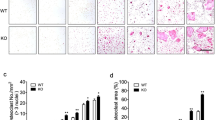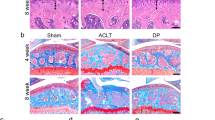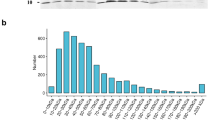Abstract
Aim:
Sinomenine (SIN) is an alkaloid found in the roots and stems of Sinomenium acutum, which has been used to treat rheumatic arthritis in China and Japan. In this study we investigated the effects of SIN on osteoclast survival in vitro and the mechanisms of the actions.
Methods:
Mature osteoclasts were differentiated from murine monocyte/macrophage cell line RAW264.7 through incubation in the presence of receptor activator of NF-κB ligand (RANKL, 100 ng/mL) for 4 d. The cell viability was detected using the CCK-8 method. The survival and actin ring construction of the osteoclasts were scored using TRACP staining and phalloidin-FITC staining, respectively. The apoptosis of the osteoclasts was detected by DNA fragmentation and Hoechst 33258 staining, and the cell necrosis was indicated by LDH activity. The activation of caspase-3 in osteoclasts was measured using Western blotting and the caspase-3 activity colorimetric method.
Results:
SIN (0.25–2 mmol/L) inhibited the viability of mature osteoclasts in dose-dependent and time-dependent manners, but did not affect that of RAW264.7 cells. Consistently, SIN dose-dependently suppressed the survival of mature osteoclasts. The formation of actin ring, a marker associated with actively resorbing osteoclasts, was also impaired by the alkaloid. SIN (0.5 mmol/L) induced the apoptosis of mature osteoclasts, which was significantly attenuated in the presence of the caspase-3 inhibitor Ac-DEVD-CHO. SIN increased the cleavage of caspase-3 in mature osteoclasts in dose-dependent and time-dependent manners. Furthermore, SIN dose-dependently enhanced caspase-3 activity, which was blocked in the presence of Ac-DEVD-CHO.
Conclusion:
Sinomenine inhibits osteoclast survival in vitro through caspase-3-mediated apoptosis, thus it is a potential agent for treating excessive bone resorption diseases.
Similar content being viewed by others
Log in or create a free account to read this content
Gain free access to this article, as well as selected content from this journal and more on nature.com
or
References
Baron R . Molecular mechanisms of bone resorption by the osteoclast. Anat Rec 1989; 224: 317–24.
Boyle WJ, Simonet WS, Lacey DL . Osteoclast differentiation and activation. Nature 2003; 423: 337–42.
Blair HC, Zaidi M, Huang CL, Sun L . The developmental basis of skeletal cell differentiation and the molecular basis of major skeletal defects. Biol Rev Camb Philos Soc 2008; 83: 401–15.
Tanaka S, Miyazaki T, Fukuda A, Akiyama T, Kadono Y, Wakeyama H, et al. Molecular mechanism of the life and death of the osteoclast. Ann N Y Acad Sci 2006; 1068: 180–6.
Stern PH . Antiresorptive agents and osteoclast apoptosis. J Cell Biochem 2007; 101: 1087–96.
Edwards JR, Weivoda MM . Osteoclasts: malefactors of disease and targets for treatment. Discov Med 2012; 13: 201–10.
Xu M, Liu L, Qi C, Deng B, Cai X . Sinomenine versus NSAIDs for the treatment of rheumatoid arthritis: a systematic review and meta-analysis. Planta Med 2008; 74: 1423–9.
Zhao XX, Peng C, Zhang H, Qin LP . Sinomenium acutum: A review of chemistry, pharmacology, pharmacokinetics, and clinical use. Pharm Biol 2012; 50: 1053–61.
Lu XL, Zeng J, Chen YL, He PM, Wen MX, Ren MD, et al. Sinomenine hydrochloride inhibits human hepatocellular carcinoma cell growth in vitro and in vivo: involvement of cell cycle arrest and apoptosis induction. Int J Oncol 2013; 42: 229–38.
Lv Y, Li C, Li S, Hao Z . Sinomenine inhibits proliferation of SGC-7901 gastric adenocarcinoma cells via suppression of cyclooxygenase-2 expression. Oncol Lett 2011; 2: 741–5.
Zhou L, Luan H, Liu Q, Jiang T, Liang H, Dong X, et al. Activation of PI3K/Akt and ERK signaling pathways antagonized sinomenine-induced lung cancer cell apoptosis. Mol Med Report 2012; 5: 1256–60.
Jiang T, Zhou L, Zhang W, Qu D, Xu X, Yang Y, et al. Effects of sinomenine on proliferation and apoptosis in human lung cancer cell line NCI-H460 in vitro. Mol Med Report 2010; 3: 51–6.
Shu L, Yin W, Zhang J, Tang B, Kang YX, Ding F, et al. Sinomenine inhibits primary CD4+ T-cell proliferation via apoptosis. Cell Biol Int 2007; 31: 784–9.
He X, Wang J, Guo Z, Liu Q, Chen T, Wang X, et al. Requirement for ERK activation in sinomenine-induced apoptosis of macrophages. Immunol Lett 2005; 98: 91–6.
Kim MH, Ryu SY, Choi JS, Min YK, Kim SH . Saurolactam inhibits osteoclast differentiation and stimulates apoptosis of mature osteoclasts. J Cell Physiol 2009; 221: 618–28.
Yonezawa T, Hasegawa S, Ahn JY, Cha BY, Teruya T, Hagiwara H, et al. Tributyltin and triphenyltin inhibit osteoclast differentiation through a retinoic acid receptor-dependent signaling pathway. Biochem Biophys Res Commun 2007; 355: 10–5.
Hwang YH, Lee JW, Hahm ER, Jung KC, Lee JH, Park CH, et al. Momordin I, an inhibitor of AP-1, suppressed osteoclastogenesis through inhibition of NF-kappaB and AP-1 and also reduced osteoclast activity and survival. Biochem Biophys Res Commun 2005; 337: 815–23.
Marie PJ . Signaling pathways affecting skeletal health. Curr Osteoporos Rep 2012; 10: 190–8.
Gu G, Mulari M, Peng Z, Hentunen TA, Vaananen HK . Death of osteocytes turns off the inhibition of osteoclasts and triggers local bone resorption. Biochem Biophys Res Commun 2005; 335: 1095–101.
Li X, Senda K, Ito A, Sogo Y, Yamazaki A . Effect of Zn and Mg in tricalcium phosphate and in culture medium on apoptosis and actin ring formation of mature osteoclasts. Biomed Mater 2008; 3: 045002.
Akiyama T, Dass CR, Choong PF . Novel therapeutic strategy for osteosarcoma targeting osteoclast differentiation, bone-resorbing activity, and apoptosis pathway. Mol Cancer Ther 2008; 7: 3461–9.
Xing L, Boyce BF . Regulation of apoptosis in osteoclasts and osteoblastic cells. Biochem Biophys Res Commun 2005; 328: 709–20.
Zimmermann KC, Bonzon C, Green DR . The machinery of programmed cell death. Pharmacol Ther 2001; 92: 57–70.
Nicholson DW . Caspase structure, proteolytic substrates, and function during apoptotic cell death. Cell Death Differ 1999; 6: 1028–42.
Szymczyk KH, Freeman TA, Adams CS, Srinivas V, Steinbeck MJ . Active caspase-3 is required for osteoclast differentiation. J Cell Physiol 2006; 209: 836–44.
Shandala T, Shen NY, Hopwood B, Yip YC, Foster BK, Xian CJ . The role of osteocyte apoptosis in cancer chemotherapy-induced bone loss. J Cell Physiol 2012; 227: 2889–97.
Piva R, Penolazzi L, Zennaro M, Bianchini E, Magri E, Borgatti M, et al. Induction of apoptosis of osteoclasts by targeting transcription factors with decoy molecules. Ann N Y Acad Sci 2006; 1091: 509–16.
Piva R, Penolazzi L, Borgatti M, Lampronti I, Lambertini E, Torreggiani E, et al. Apoptosis of human primary osteoclasts treated with molecules targeting nuclear factor-kappaB. Ann N Y Acad Sci 2009; 1171: 448–56.
Acknowledgements
This work was supported by the National Natural Science Foundation of China (81073119, 30801413) to Xiao-juan LI and the Guangdong Pearl River Scholar Funded Scheme to Shuwen LIU.
Author information
Authors and Affiliations
Corresponding authors
Rights and permissions
About this article
Cite this article
He, Lg., Li, Xl., Zeng, Xz. et al. Sinomenine induces apoptosis in RAW 264.7 cell-derived osteoclasts in vitro via caspase-3 activation. Acta Pharmacol Sin 35, 203–210 (2014). https://doi.org/10.1038/aps.2013.139
Received:
Accepted:
Published:
Issue date:
DOI: https://doi.org/10.1038/aps.2013.139
Keywords
This article is cited by
-
Small-molecule amines: a big role in the regulation of bone homeostasis
Bone Research (2023)
-
In-vitro evaluation of apoptotic effect of OEO and thymol in 2D and 3D cell cultures and the study of their interaction mode with DNA
Scientific Reports (2018)
-
Aconine inhibits RANKL-induced osteoclast differentiation in RAW264.7 cells by suppressing NF-κB and NFATc1 activation and DC-STAMP expression
Acta Pharmacologica Sinica (2016)
-
Ferulic acid impairs osteoclast fusion and exacerbates survival of mature osteoclasts
Cytotechnology (2016)



